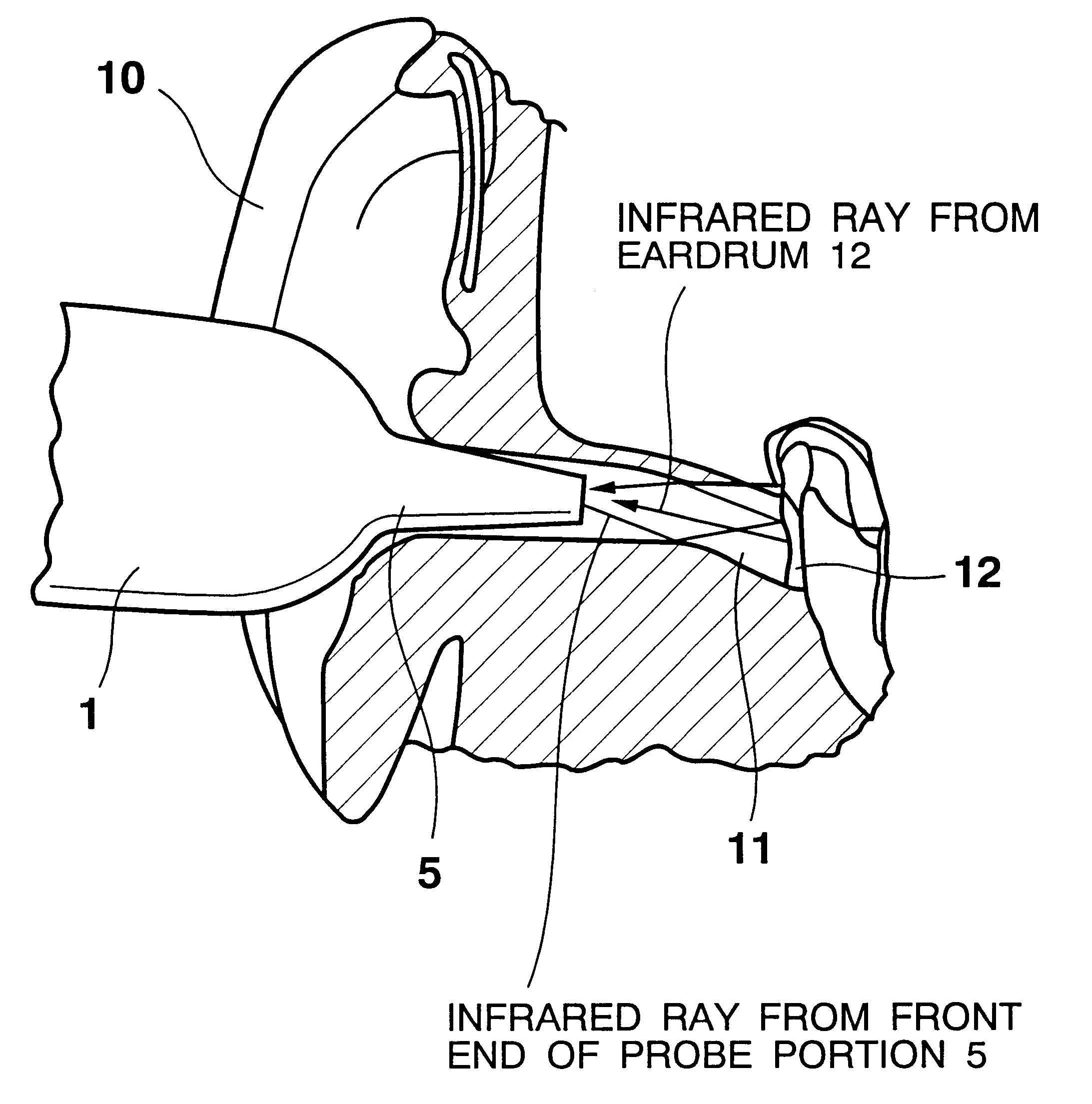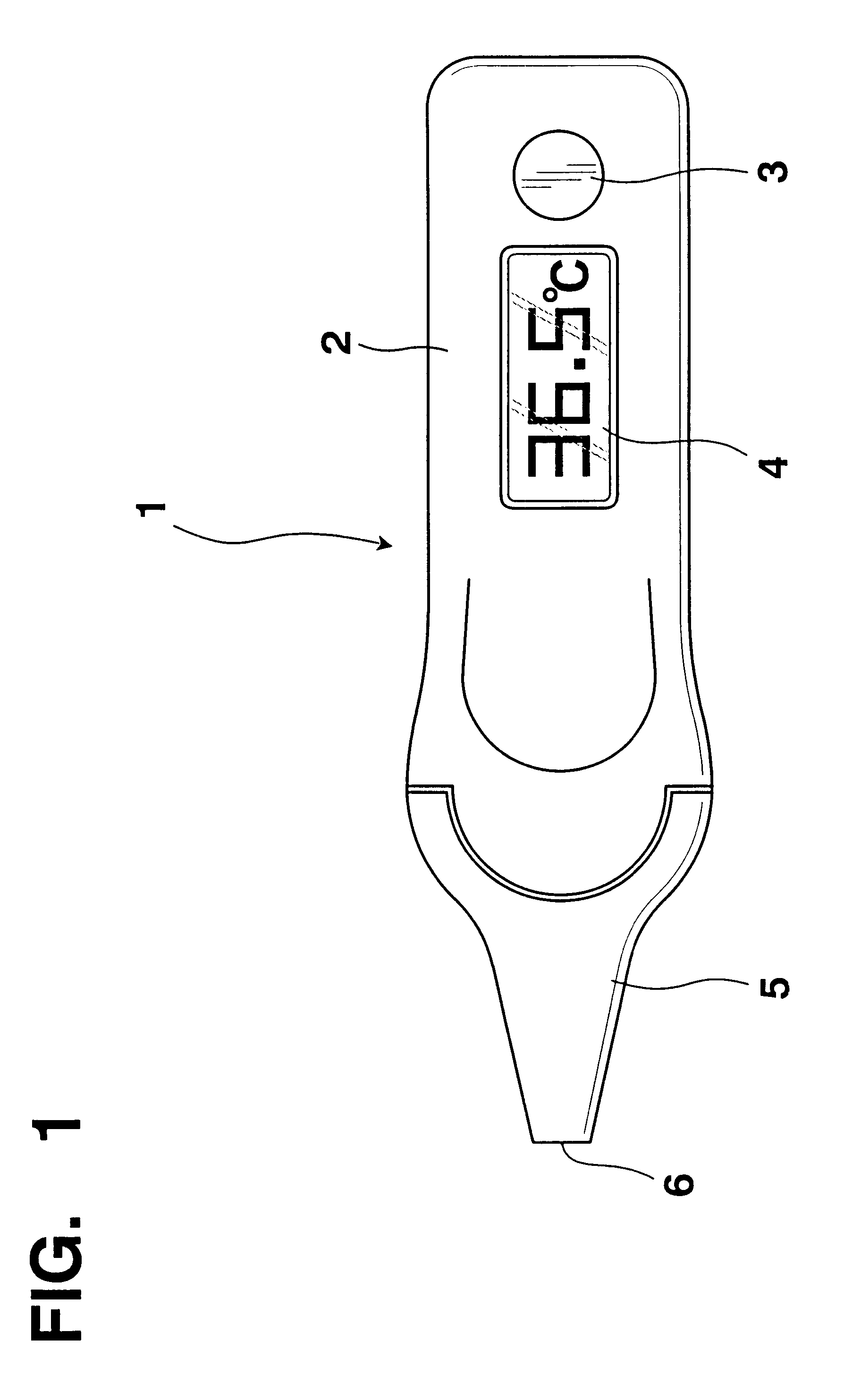Radiation clinical thermometer
a thermometer and clinical technology, applied in the field of radiation thermometers, can solve the problems of affecting the accuracy of the measurement, the need for a probe cover, and the smudging of the front end of the probe portion,
- Summary
- Abstract
- Description
- Claims
- Application Information
AI Technical Summary
Benefits of technology
Problems solved by technology
Method used
Image
Examples
first embodiment
FIG. 1 is a schematic view of a radiation thermometer according to the present invention.
As shown in FIG. 1, a radiation thermometer 1 has a measuring switch 3 and a display 4 on case means 2. A probe portion 5 is provided at the front end of the case means 2.
The probe portion 5 has a conical trapezoidal shape with its diameter gradually increasing from the front end toward the rear end. The probe portion 5 is structured such that when the probe portion 5 is inserted into an external acoustic opening, the external acoustic opening is almost filled with a portion of the probe portion 5 thicker than the external acoustic opening. The shape of the probe portion is not necessarily limited to this so long as the probe portion substantially fills the external acoustic opening.
For measuring a body temperature, the measuring switch 3 is depressed, and then the front end of the probe portion 5 is inserted into an external acoustic opening 11. The radiation thermometer 1 starts the measuremen...
second embodiment
the present invention will be explained next.
FIG. 8 is a cross-sectional view of a probe portion 5 of a radiation thermometer according to a second embodiment of the present invention.
A difference from the embodiment shown in FIG. 3 is that there is no thermistor 21.
A difference between a temperature of an infrared ray sensor 18 and a temperature of the front end of a probe portion 5 is smaller than a difference between a temperature of an eardrum 12 or an external acoustic opening 11 as an object under measurement and a temperature of the front end of the probe portion 5. Therefore, in order to simplify the structure, the thermistor 21 shown in FIG. 3 can be substituted with the thermistor 20.
In this case, T.sub.0 can be set to T.sub.p in the expression 2. The operation to be carried out by the operational circuit 28a is given by expression 3.
T.sub.b =(T.sub.0.sup.4 +V.sub.b / Ke).sup.1 / 4 (3)
In the present embodiment, an output voltage of the thermistor 20 can be used as the tempera...
third embodiment
the present invention will be explained next.
In the third embodiment, it is an object to simplify the structure and to increase the processing speed by approximating the numerical expression given in the expression (3) in terms of a more simple expression.
When the function f (T)=T.sup.4 is depicted into a graph in respect to T as an absolute temperature, a curve as shown in FIG. 9 is obtained. In FIG. 9, a horizontal axis represents T and a vertical axis represents f (T).
In the curve shown in FIG. 9, when the radiation thermometer 1 is actually used at an environmental temperature (that is, when a range of the temperature T.sub.0 of the infrared ray sensor 18 is observed), a narrow range of about 288.degree. K (15.degree. C.) to 308.degree. K (35.degree. C.) will be noted, assuming that the radiation thermometer 1 is usually used indoors. Further, a temperature range of the eardrum 12 or the external acoustic opening 11 that is the object under measurement is about 308.degree. K (35...
PUM
| Property | Measurement | Unit |
|---|---|---|
| emissivity | aaaaa | aaaaa |
| thickness | aaaaa | aaaaa |
| emissivity | aaaaa | aaaaa |
Abstract
Description
Claims
Application Information
 Login to View More
Login to View More - R&D
- Intellectual Property
- Life Sciences
- Materials
- Tech Scout
- Unparalleled Data Quality
- Higher Quality Content
- 60% Fewer Hallucinations
Browse by: Latest US Patents, China's latest patents, Technical Efficacy Thesaurus, Application Domain, Technology Topic, Popular Technical Reports.
© 2025 PatSnap. All rights reserved.Legal|Privacy policy|Modern Slavery Act Transparency Statement|Sitemap|About US| Contact US: help@patsnap.com



